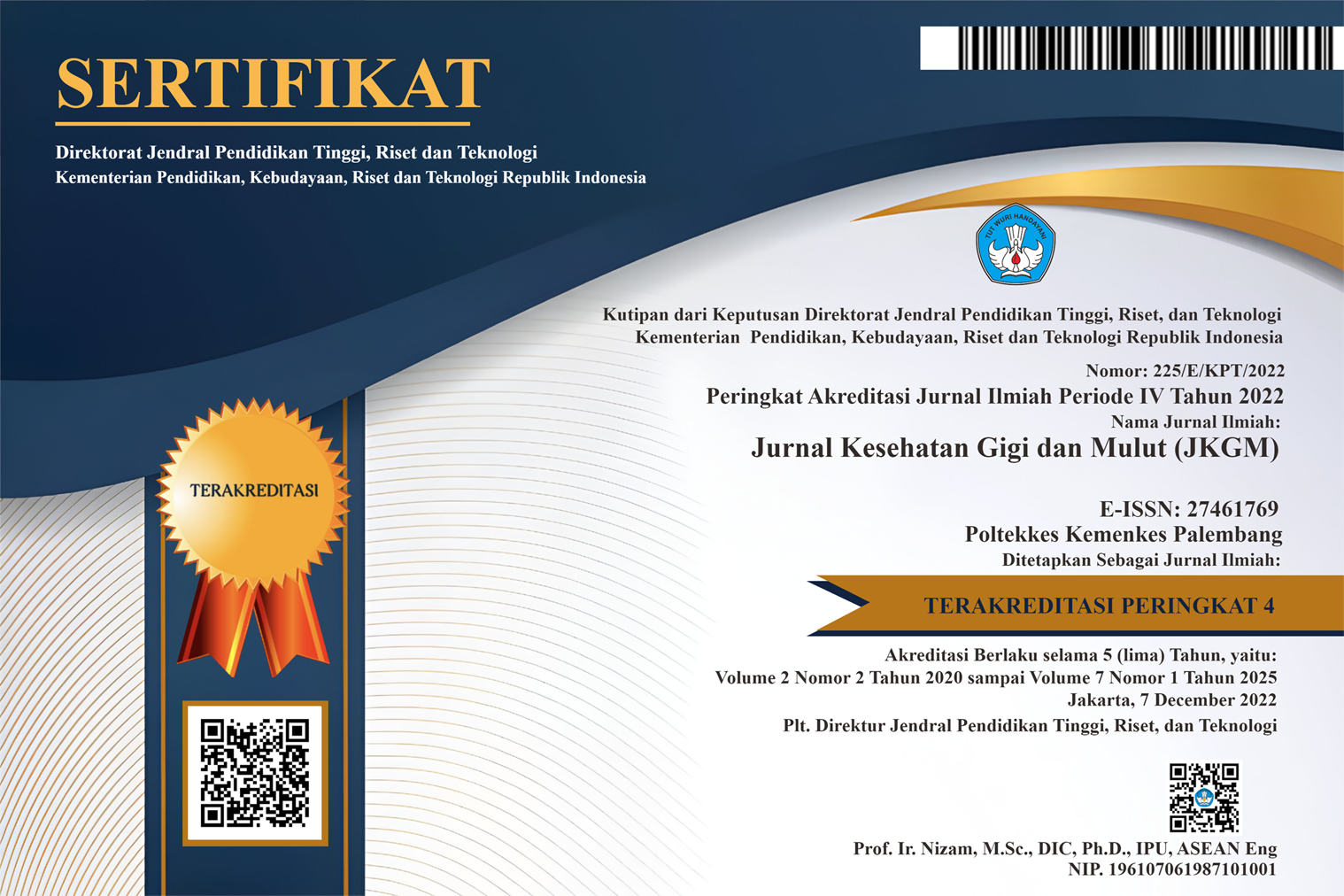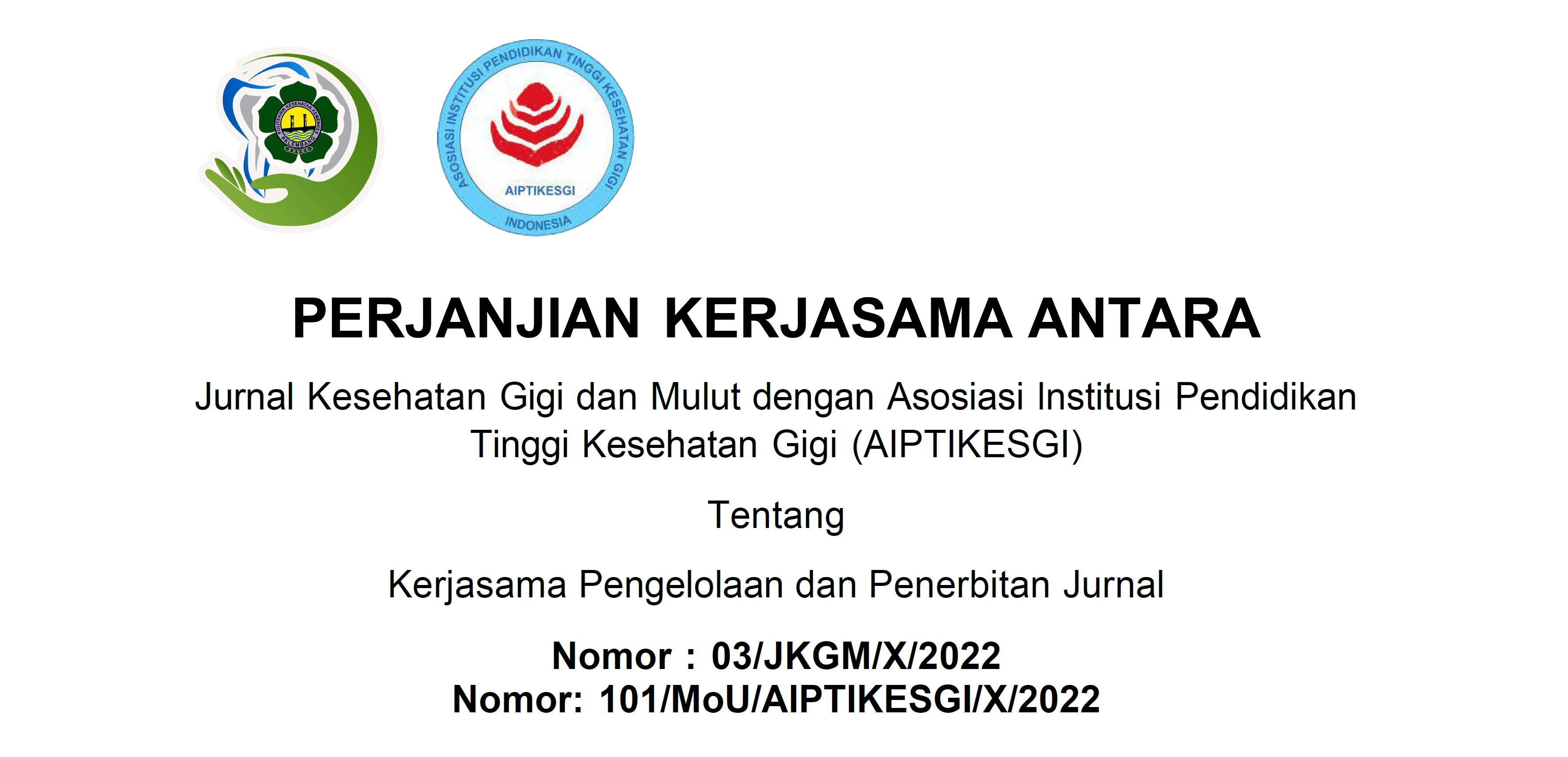TOPIKAL APLIKASI FLUOR DALAM MENCEGAH KARIES GIGI PADA ANAK – SEBUAH LITERATURE REVIEW
Abstract
Maintaining oral and dental health is very important to achieve optimal body health, so it must start from the time of the primary teeth. The health of a child's primary teeth will determine the condition of the permanent teeth that will replace them. The most common dental and oral health problem is dental caries. Based on the results of Riskesdas data, the incidence of dental caries in Indonesia is still very high, so efforts and prevention of dental caries are needed. There are three types of prevention that can be done to prevent dental caries, namely primary, secondary and tertiary prevention. The earliest action is primary prevention. The main steps to prevent caries are effective for teeth that are still healthy or when initial caries occurs. Initial caries is characterized by demineralization of tooth enamel but no cavity formation. The primary stage of caries prevention includes dental health education, maintaining dental health, regular dental examinations, administering fissure sealants, and administering Topical Applications Fluoride (TAF). TAF is one of the most effective in preventing caries. TAF is a simple technique for application of fluoride solutions by dental practitioners and can be applied easily. This treatment is highly recommended for children who have just erupted in the mouth to strengthen the tooth enamel layer.
References
2. Wilkins EM. Clinical Practice of Dental Hygienist 13th Ed. Philadelpia : Wolters. 2020. p : 370
3. Neidle EA, Yagiela JA. Pharmacology and Therapeutics for Dentistry 7th Ed. St Louis : Mosby. 2019. p : 298
4. Prastiwi S, Nita N, Fathimah AA. (2019). Pencegahan Karies dengan Aplikasi Topikal Fluoride pada Anak Usia 12-13 Tahun. Jurnal Pengabdian Kesehata Masyarakat.
5. Berliana E, Wardani I, & Juniar E. (2016). Efektivitas Topikal Aplikasi Fluoride Menggunakan Ekstrak Teh Hijau Dibandingkan Dengan Sodium Fluoride Pada Gigi Sapi.
6. Prasko, Sutomo B, & Santoso B. (2016 ) Penyuluhan Metode Audio Visual dan Demonstrasi Terhadap Pengetahuan Menyikat Gigi Pada Anak Sekolah Dasar. Jurnal Kesehatan Gigi Vol.03 No.2, Desember
7. Nonong, YH. (2011). Penggunaan Silver Diamine Fluoride Sebagai Bahan Anti Karies. Prosiding Temu Ilmiah Bandung Dentistry 8 : 39-46
8. Mullane, D.M., Baez, R.J., Jones, S., Lennon, M.A., Petersen, P.E., Rugg- Gunn, A.E., Whelton, H., Whitford, G. M. Fluoride and Oral Health. Community Dent. Health 33, 69–99 (2016).
9. Tinanoff, N. Use of Fluoride 2nd Ed. (Wiley-Blackwell, 2016). p : 520-521
10. Mazyad, O.T., El-marakby, A.M., Sorour, Y.R., Abo-ghannam, M.D., Salem, M.M., Salamah, M.A., Hawrani, A.M., Showaill, A. A. Topical Application of Fluoride and It’s Anti Cariogenic Effect. Int. J. Adv. Res., 5(12), 1483–1488 (2017).
11. Chukwumah, N., Morenike, O.F., Elizabeth, Alice, A. U. Impact of Dental Caries and Its Treatment on The Quality of Life of 12 to 15 Year Old Adolescents in Benin. (2015).
12. Broadbent, J.M., Thomson, W.M., Ramrakha, S. Community Water Fluoridetion and Intelligence: Prospective Study in New Zealand. Am J Public Heal. 105 (1), 72–76 (2017).
13. Sutton, N., Kiersey, R., Farragher, L. and Long, J. Health Effects of Water Fluoridetion, Health Research Board. (2015).
14. Iheozor-Ejiobar, Z., Worthington H.V., Walsh, T., O’Malley, L., Clarkson, J. E., Macey, R., Alam, R., Tugwell, P., Welch, V. and Glenny, A.M. Water fluoridetion for the Prevention of Dental Caries (Review). Cochrane Libr. 6 (2), (2015)
15. Ankita Bansa et all. 2023. Topical fluoride application in dentistry by professionals: A literature review. Archives of Dental Research 2023;13(2):83–86
16. Horst, J.A., Ellenikiotis, H., Milgrom, P. L. UCSF Protocol for Caries Arrest Using Silver Diamine Fluoride: Rationale, Indications and Consent. J. Calif. Dent. Assoc. 44(1), 16–28 (2016). .
17. Giusti, L., Steinborn, C., Steinborn, M. Use of Silver Diamine Fluoride for The Maintenance of Dental Prostheses in a High Caries Risk Patient: A Medical Management Approach. J Prosthet Dent 2(31, (2017).
18. Endrawati L. Penggunaan Silver Diamina Fluoride (SDF) 38% sebagai Arresting Caries Treatment (ACT) pada Anak-anak. Maj Kedokt Andalas. 2011;35(2):98.
19. Seyed Akhavan P, et all. 2017. Effect of Fluoride Gel and Foam on Salivary Fluoride Concentration. Journal of Research in Dental and Maxillofacial Sciences.
20. Ayman Sabbah dan Inas Helwa. 2022. Efficiency of nano silver fluoride on prevention of dental caries on intact enamel surface assessed by edx-analysis (in vitro study). Egyptian Dental Journal.
21. Amol Patil, et all. 2024. Nano-Silver Fluoride in Preventive Dentistry: A Literature Review. International Journal for Multidisciplinary Research E-ISSN: 2582-2160.
22. Mazyad O, marakby A, Sorour Y, ghannam M, Salem M, Salamah M, et al. Topical Application of Fluoride and Its Anti-Cariogenic Effect. Int J Adv Res. 2017;5(12):1483–8.
23. Arthur J. Nowak, et all. Pediatric Dentistry 6th Ed. Elsevier :USA. 2017. p : 870
24. Udijanto Tedjosasongko. 2019. Aktivitas karies gigi setelah aplikasi topikal gel Acidulated Phosphate Fluoride (APF) 1,23%. Indonesian Pediatric Dental Journal ISN : 1979-8792
Copyright (c) 2024 Jurnal Kesehatan Gigi dan Mulut (JKGM)

This work is licensed under a Creative Commons Attribution-ShareAlike 4.0 International License.
Authors who publish with this journal agree to the following terms:
- Authors retain copyright and grant the journal right of first publication with the work simultaneously licensed under a Creative Commons Attribution License that allows others to share the work with an acknowledgement of the work's authorship and initial publication in this journal.
- Authors are able to enter into separate, additional contractual arrangements for the non-exclusive distribution of the journal's published version of the work (e.g., post it to an institutional repository or publish it in a book), with an acknowledgement of its initial publication in this journal.
- Authors are permitted and encouraged to post their work online (e.g., in institutional repositories or on their website) prior to and during the submission process, as it can lead to productive exchanges, as well as earlier and greater citation of published work















